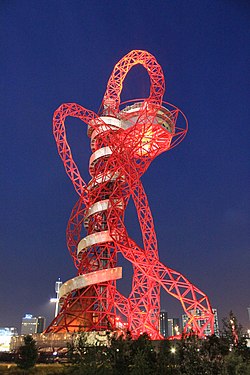
Back ArcelorMittal Orbit Afrikaans আর্সেলরমিত্তাল অরবিট Bengali/Bangla ArcelorMittal Orbit Czech ArcelorMittal Orbit Welsh ArcelorMittal Orbit German ArcelorMittal Orbit Spanish ArcelorMittal Orbit Estonian Tour Orbit French ארסלורמיטאל אורביט HE ArcelorMittal Orbit ID
| ArcelorMittal Orbit | |
|---|---|
 | |
 | |
| General information | |
| Type | Observation tower |
| Location | Queen Elizabeth Olympic Park London, E20 United Kingdom |
| Coordinates | 51°32′18″N 0°0′48″W / 51.53833°N 0.01333°W |
| Estimated completion | May 2012 |
| Opened | April 2014 |
| Cost | £22.7 million |
| Owner | Olympic Park Legacy Company (on completion), ownership transferred to London Legacy Development Corporation |
| Management | ENGIE Services Limited on behalf of London Legacy Development Corporation |
| Height | 114.5 m (376 ft) |
| Technical details | |
| Floor area | 300 m2 (3,229 sq ft) |
| Design and construction | |
| Architect(s) | Designed by Anish Kapoor with Sir Cecil Balmond of Arup Group, architect Ushida Findlay Architects[1][2] |
| Developer | Arcelor Mittal and London Development Agency |
| Structural engineer | Arup |


The ArcelorMittal Orbit (often referred to as the Orbit Tower or its original name, Orbit) is a 114.5-metre (376-foot) sculpture and observation tower in Queen Elizabeth Olympic Park in Stratford, London. It is Britain's largest piece of public art,[3] and is intended to be a permanent lasting legacy of London's hosting of the 2012 Summer Olympic and Paralympic Games, assisting in the post-Olympics regeneration of the Stratford area. Sited between London Stadium (formerly called Olympic Stadium) and the Aquatics Centre, it allows visitors to view the whole Olympic Park from two observation platforms.
Orbit was designed by Turner-Prize winning artist Anish Kapoor and Cecil Balmond of Arup Group, an engineering firm. Announced on 31 March 2010, it was expected to be completed by December 2011. The project came about after Mayor of London Boris Johnson and Olympics Minister Tessa Jowell decided in 2008 that the Olympic Park needed "something extra". Designers were asked for ideas for an "Olympic tower" at least 100 metres (330 ft) high: Orbit was the unanimous choice from proposals considered by a nine-person advisory panel. Kapoor and Balmond believed that Orbit represented a radical advance in the architectural field of combining sculpture and structural engineering, and that it combined both stability and instability in a work that visitors can engage with and experience via an incorporated spiral walkway. It has been both praised and criticised for its bold design, and has especially received criticism as a vanity project of questionable lasting use or merit as a public art project.
The project was expected to cost £19.1 million, with £16 million coming from Britain's then-richest man, the steel tycoon Lakshmi Mittal, Chairman of the ArcelorMittal steel company, and the balance of £3.1 million coming from the London Development Agency. The name "ArcelorMittal Orbit" combines the name of Mittal's company, as chief sponsor, with Orbit, the original working title for Kapoor and Balmond's design.
The ArcelorMittal Orbit temporarily closed after the 2012 Olympic and Paralympic Games while the South Plaza (in which Orbit is positioned) underwent reconstruction for its long-term legacy use as a public outdoor space. It re-opened to the public on 5 April 2014. The structure incorporates the world's tallest and longest – 178 m (584 ft) – tunnel slide, designed by Carsten Höller. The idea was originally envisioned by the London Legacy Development Corporation as a way to attract more visitors to the tower. The slide includes transparent sections to give a "different perspective" of the twisting red tower and was completed in June 2016. This follows an option to abseil down the tower, introduced in 2014.
- ^ ArcelorMittal Orbit Perspectives Archived 22 June 2012 at the Wayback Machine, retrieved 15 June 2012
- ^ Chozick, Amy (1 June 2012). "A Lightning Rod Masquerading as a Sculpture". New York Times. Retrieved 15 June 2012.
- ^ Tim Adams: "Anish Kapoor's Orbit tower: the mother of all helter-skelters" in The Guardian, 5 May 2012
© MMXXIII Rich X Search. We shall prevail. All rights reserved. Rich X Search